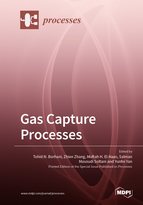Gas Capture Processes
A special issue of Processes (ISSN 2227-9717). This special issue belongs to the section "Environmental and Green Processes".
Deadline for manuscript submissions: closed (15 September 2019) | Viewed by 111311
Special Issue Editors
Interests: process modeling and simulation; chemometric and AI; energy conversion and storage
Special Issues, Collections and Topics in MDPI journals
Interests: gas separation; CO2 capture; polymeric membrane; membrane separation; membrane contactor; membrane absorption; modeling; membrane preparation; membrane characterization
Special Issues, Collections and Topics in MDPI journals
Interests: water treatment and purification; biotechnology; electrocoagulation; CO2 capture and utilization; membrane separation and plasma technology
Special Issues, Collections and Topics in MDPI journals
Interests: separation processes; process synthesis and design; carbon capture and utilisation
Special Issues, Collections and Topics in MDPI journals
2. School of Energy and Power Engineering, Chongqing University, Chongqing 400044, China
Interests: self-adaptive control cooling for electronic devices via hydrogels; cooling via self-adaptive evaporative hydrogel; application of hydrogels in fluid and heat control
Special Issues, Collections and Topics in MDPI journals
Special Issue Information
Dear Colleagues,
Gas emissions from industries and human activities represent a global threat to the atmosphere and human health. Recently, gas emissions control technologies have been employed widely in a variety of fields, such as CO2, CO, SO2, H2S, NOX, H2, etc. However, in the specific areas, some capturing methods show poor performance not only in term of cost but also in terms of energy consumptions. Thus, the choice of a good gas capture method is very significant to the various industrial processes and the small-scale applications. It is important to conduct the proper analysis of the main factors that influence the process and identify the mechanisms of the different phases of the processes.
This Special Issue on “Gas Capture Processes” aims to identify novel advances in the development and application of experimental and modeling work to address longstanding challenges in gas capture processes. Topics include, but are not limited to, the following:
- Gas separation from gas mixture;
- Optimization and comparison of the gas capture processes;
- Mechanism and thermodynamics of CO2 and other phases;
- Multiphase flow during the capturing process; and
- The development of gas capture applications.
Dr. Tohid N.Borhani
Dr. Zhien Zhang
Dr. Muftah H. El-Naas
Dr. Salman Masoudi Soltani
Dr. Yunfei Yan
Guest Editors
Manuscript Submission Information
Manuscripts should be submitted online at www.mdpi.com by registering and logging in to this website. Once you are registered, click here to go to the submission form. Manuscripts can be submitted until the deadline. All submissions that pass pre-check are peer-reviewed. Accepted papers will be published continuously in the journal (as soon as accepted) and will be listed together on the special issue website. Research articles, review articles as well as short communications are invited. For planned papers, a title and short abstract (about 100 words) can be sent to the Editorial Office for announcement on this website.
Submitted manuscripts should not have been published previously, nor be under consideration for publication elsewhere (except conference proceedings papers). All manuscripts are thoroughly refereed through a single-blind peer-review process. A guide for authors and other relevant information for submission of manuscripts is available on the Instructions for Authors page. Processes is an international peer-reviewed open access monthly journal published by MDPI.
Please visit the Instructions for Authors page before submitting a manuscript. The Article Processing Charge (APC) for publication in this open access journal is 2400 CHF (Swiss Francs). Submitted papers should be well formatted and use good English. Authors may use MDPI's English editing service prior to publication or during author revisions.
Keywords
- Air pollution
- Gas separation
- Gas capture
- Process optimization










